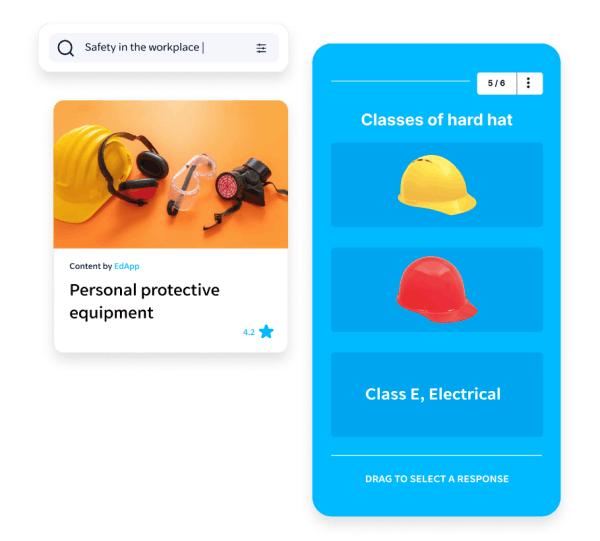10 Behavior Based Safety Topics

An effective way to improve workplace safety is by discussing behavior-based safety topics. Teaching these topics will educate workers on safe practices and promote a positive safety culture in the workplace. In this article, we’ll look at behavior based safety topics to help mitigate and reduce any risks, hazards, and accidents at work.
1. Leadership Commitment
Leadership commitment is a critical behavior based safety topic because it’s a key factor in promoting and sustaining a strong safety culture in an organization. When leaders actively encourage safe behaviors, employees are more likely to perceive safety as a shared responsibility and be more motivated to participate in safety initiatives.

Leadership commitment is the foundation of any successful safety program. Management must prioritize safety by leading by example, offering resources, and actively engaging employees in safety activities. Leaders who demonstrate a commitment to safety set the tone for the entire organization.
Train and learn with EdApp today!
2. Employee Involvement
After getting leadership commitment, getting your employees’ involvement is the next thing you have to focus on. Employees are the most valuable resource in any organization, and involving them in safety programs is critical. As they’re often the ones with the most direct knowledge of the hazards and risks that exist in their work environment, they can offer meaningful insights and identify potential hazards that may be overlooked by management. Additionally, involving employees in safety programs can also improve their engagement and motivation.

3. Hazard Identification
Hazard identification is an essential part of any safety program. One effective way to identify hazards is to conduct regular workplace inspections, training your workers on hazard identifcation, and managing hazard assessments to help prevent accidents and injuries. By actively identifying hazards and risks, employees can take proactive steps to prevent accidents and injuries.
For example, if an employee recognizes a potential hazard in the workplace, they can report it to their supervisor or safety team. They can then take appropriate action to mitigate or eliminate the hazard. This can include implementing new safety procedures or practices, giving additional training or equipment, or modifying the work environment.

Already using iAuditor as your workplace inspection or safety training app? Learn from your iAuditor issues. Send EdApp training to your team’s smartphones through the training tab in your iAuditor account – no additional sign-in required.
4. Risk Assessment
Effective risk assessment involves identifying hazards, assessing the likelihood and severity of potential consequences, and determining appropriate controls or measures to mitigate those risks. This process can be incorporated into regular safety audits and inspections to make sure that hazards are identified and controlled before they can cause harm.

The behavior-based safety topic to risk assessment recognizes that risk assessment is an active process that requires constant awareness and engagement from employees. Regularly training your workers on risk assessment can also help them remember what they need to inspect and how to inspect it. It also acknowledges that employees are often best positioned to identify and assess the risks associated with their work, and that’s why they should be empowered to do so.
5. Safety Training
Safety training is an essential behavior based safety topic to make sure employees are aware of potential hazards and how to avoid them. All employees should receive regular safety training, and new employees must receive comprehensive safety training during their orientation. This includes training on safe work practices, the proper use of personal protective equipment, hazard identification and reporting, emergency response procedures, and other safety-related topics.

To help you conduct workplace safety training, you can check EdApp’s course library and easily deliver courses such as PPE for Construction, Safe Use of Machinery, and Electrical Safety. With well-designed and informative lessons, your learners will be able to have a better grasp and retention of your training content.
6. Incident Investigation
Incident investigation involves gathering information about an incident, analyzing its root cause, and developing corrective actions to prevent similar incidents from happening in the future. This is significant in understanding the cause of accidents and injuries at work. Organizations can then identify gaps in their safety programs and take the necessary actions to address them. Discussing safety training topics like this also helps organizations comply with regulatory requirements and to maintain a safe and healthy workplace.

7. Safety Observations
Safety observations involve identifying potential hazards and unsafe conditions in the workplace. This behavior based safety topic can help your workers better identify hazards that may have been overlooked while also encouraging safe behavior among employees. By observing and recording behaviors, employees can identify potential hazards or risks and take action to mitigate them. This can include delivering feedback to colleagues, addressing hazards or risks, or making suggestions for improvements.

8. Positive Reinforcement
Positive reinforcement is a powerful tool to promote safe behavior. Recognizing employees who exhibit safe behavior can improve motivation and encourage others to follow suit. This involves reinforcing safe behaviors through positive outcomes, which increases the possibility of those behaviors being repeated in the future. In the context of workplace safety, positive reinforcement can be used to encourage employees to engage in safe behaviors and to create a safety culture within the organization.

Create a buzz and reward your employees with real prizes! With EdApp, learners can complete their training to snag the #1 spot and compete for a prize of their choice – whether that’s 5 USD for a nearby coffee shop, a new pair of headphones, or a voucher for a global brand.
9. Near Miss Reporting
Near miss reporting is the process of reporting incidents that could’ve resulted in an accident or injury but didn’t. Reporting near misses can help identify potential hazards and prevent accidents before they happen. The behavior based safety topic encourages employees to be proactive in identifying potential hazards and taking action to prevent them from causing harm. This requires a behavior change in employees to be more aware of their surroundings and to report any unsafe conditions or actions, even if no harm was done.

10. Continuous Improvement
Continuous improvement is critical in maintaining an effective safety program. Regularly reviewing and evaluating the safety program can help identify areas for improvement and implement corrective actions.

Continuous improvement requires a behavior change in employees to be willing to learn from mistakes, to be open to feedback, and to be willing to try new approaches. It also involves a culture shift where continuous improvement is valued as a key component of safety performance, and where employees are empowered to make suggestions for improvement.
Author
Gabrielle Rivera
Gabrielle is an eLearning content writer for EdApp, a microlearning solution designed for today's digital habits. She creates content about cutting-edge learning technologies and resources to help companies deliver great training experiences. When not absorbed in writing, she spends her time playing video games and reading books.
